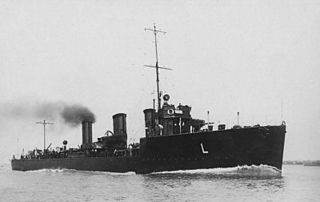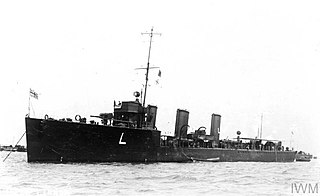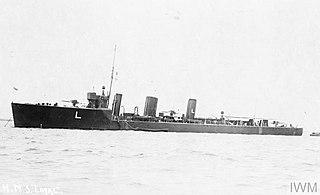Description
The Laforey class were improved and faster versions of the preceding Acastaclass. [1] They displaced 965–1,010 long tons (980–1,026 t). The ships had an overall length of 268 feet 10 inches (81.9 m), a beam of 27 feet 8 inches (8.4 m) and a draught of 10 feet 6 inches (3.2 m). Legion was powered by two Parsons direct-drive steam turbines, each driving one propeller shaft, using steam provided by four Yarrow boilers. [2] The turbines developed a total of 24,500 shaft horsepower (18,300 kW) and gave a maximum speed of 29 knots (54 km/h; 33 mph). The ships carried a maximum of 280 long tons (280 t) of fuel oil that gave them a range of 1,750 nautical miles (3,240 km; 2,010 mi) at 15 knots (28 km/h; 17 mph). The ships' complement was 74 officers and ratings. [3]
The ships were armed with three single QF 4-inch (102 mm) Mark IV guns and two QF 1.5-pounder (37 mm) anti-aircraft guns. These latter guns were later replaced by a pair of QF 2-pounder (40 mm) "pom-pom" anti-aircraft guns. The ships were also fitted with two above-water twin mounts for 21-inch (533 mm) torpedoes. They were equipped with rails to carry four Vickers Elia Mk IV mines, although these rails were never used. [3]

HMS Lydiard was a Laforey-class destroyer built for the Royal Navy during the 1910s.

The Laforey class was a class of 22 torpedo boat destroyers of the Royal Navy, twenty of which were built under the Naval Programme of 1912–13 and a further two under the 2nd War Emergency Programme of 1914. As such they were the penultimate pre-war British destroyer design. All served during World War I during which three were lost; the survivors were all scrapped in 1921-23.
HMS Ossory was an Admiralty M-class destroyer built for the Royal Navy during the First World War. She took part in the Battle of Jutland in 1916 and was sold for scrap in 1921.
HMS Nomad was an Admiralty M-class destroyer built for the Royal Navy during the First World War. She was sunk during the Battle of Jutland in 1916.
HMS Phoebe was an Admiralty M-class destroyer built for the Royal Navy during the First World War. She took part in the Zeebrugge Raid in 1918 and was sold for scrap in 1921.

HMS Laertes was a Laforey-class destroyer built for the Royal Navy during the 1910s.
HMS Lassoo was a Laforey-class destroyer built for the Royal Navy during the 1910s.
HMS Turbulent was an S-class destroyer built for the Royal Navy during the First World War.
HMS Ophelia was an Admiralty M-class destroyer built for the Royal Navy during the First World War, entering service in 1916. The ship served at the Battle of Jutland on 31 May/1 June 1916, and sank a German submarine in 1918. She was sold for scrap in 1921.

HMS Lennox was a Laforey-class destroyer built for the Royal Navy during the 1910s.

HMS Loyal was a Laforey-class destroyer built for the Royal Navy during the 1910s.
HMS Onslow was an Admiralty M-class destroyer built for the Royal Navy during the First World War. She took part in the Battle of Jutland in 1916 and was sold for scrap in 1921.

HMS Louis was a Laforey-class destroyer built for the British Royal Navy during the 1910s. She participated in the Dardanelles campaign, during which she was wrecked in Suvla Bay in 1915.
HMS Narborough was an Admiralty M-class destroyer built for the Royal Navy during the First World War. She was wrecked after running aground in 1918.

HMS Partridge was a Royal Navy Admiralty M-class destroyer constructed and then operational in the First World War, later being sunk by enemy action in 1917. The destroyer was the sixth Royal Navy vessel to carry the name HMS Partridge.
HMS Pheasant was one of 85 Admiralty M-class destroyers built during the First World War for the Royal Navy. She hit and was sunk by a mine in 1917.
HMS Recruit was a R-class destroyer built for the Royal Navy during the First World War. She was sunk by a German U-boat four months after she was commissioned in April 1917.

HMS Telemachus was a R-class destroyer of the British Royal Navy that took part in the First World War. She was built in 1916–1917 by the Scottish shipbuilder John Brown at their Clydebank shipyard. Telemachus was modified to serve as a minelayer, laying minefields in the German Bight and English Channel to restrict the operation of German submarines. The ship survived the war and was sold for scrap in 1927.

HMS Nereus was a Admiralty M-class destroyer which served with the Royal Navy during the First World War. Launched on 24 February 1916, the vessel served with the Grand Fleet until the end of the conflict. The vessel operated as part for Thirteenth Destroyer Flotilla in support of convoy operations. After the conflict, the destroyer was worn out by the demands of high speed operation in poor weather. Nereus was placed in reserve and subsequently sold for scrap on 15 November 1921 after less than six years service.

HMS Linnet was a Laforey-class destroyer that served with the Royal Navy during the First World War. Launched on 16 August 1913 as HMS Havock, the ship was renamed on 30 September under an Admiralty order to become one of the first destroyers in a class named alphabetically. This convention subsequently became the norm. On commissioning, the vessel joined the Third Destroyer Flotilla and operated as part of the Harwich Force. The destroyer was first commanded by Commander Loftus Jones who named his daughter Linnette after the ship. During the War, the destroyer took part in the Battle of Heligoland Bight in 1914, and escorted minelayers on missions to lay mines. It was during one the latter missions that the ship was nearly hit by a gun hurled from the stricken minelayer Amphion. With the cessation of hostilities, the ship was placed in reserve and sold to be broken up on 4 November 1921.
This page is based on this
Wikipedia article Text is available under the
CC BY-SA 4.0 license; additional terms may apply.
Images, videos and audio are available under their respective licenses.










